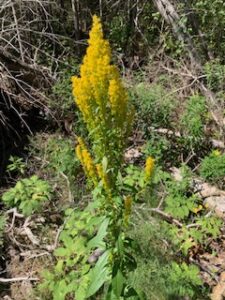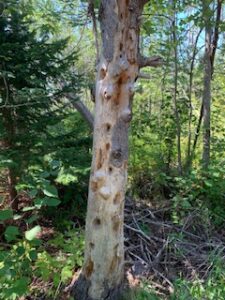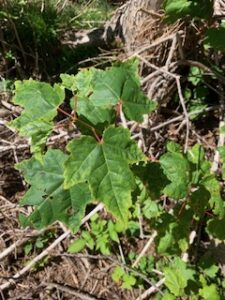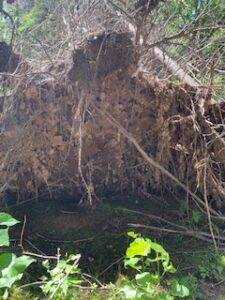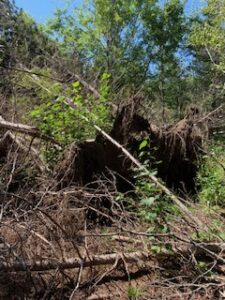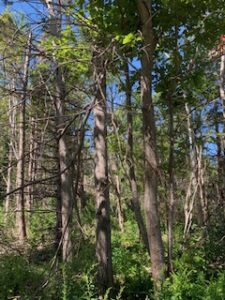Date Visited: August 24, 2023 at 12:45 pm
Weather: Sunny blue skies with few clouds
Season: End of summer
Humidity: 61%
Temperature: 20°C
Wind: 6 km/h NW
The study area is around 1 acre in size, and is a densely forested area next to the driveway at my cottage. The study area is located in Malagash, Nova Scotia, on the coast of the Northumberland Strait. It does not have any official designation. This area has very little human impact. Since the forest is so dense, and the vegetation so thick and tall, it is not used for recreation at all. The only human impact this area has is that it is within an acre’s distance of my family’s small cottage. The overall general area of Malagash is very rural with few cottages spread throughout. As such, there is a lot of wildlife and natural landscapes.
The area is a relatively flat, and has a forest with many different species of trees and other vegetation. The forest consists of both coniferous and deciduous trees. Some of the trees are quite tall and old, and some are young, with some in the middle stages. There is little grass within the forested area, mostly moss and shrubs and flowers, and the forest floor is mostly detritus – pine needles and dead leaves. The forest floor is also moist and soft in some areas. There were many different types of insects, like spiders, flies, mosquitoes, butterflies, bees, etc. There were also birds and squirrels observed. Other animals known to frequent the area but not seen during initial observations are deer, bears, skunks and porcupines. Among the plants observed, some were identified as the large-leaved aster, the whorled wood aster, the bog goldenrod, the sensitive fern, the live-forevers, young red maples, and young quaking aspens.
The study area was subjected to Hurricane Fiona in September of 2022. As such, many of the larger trees have fallen, due to the high wind force during the hurricane. The large trees that fell have huge root mats that came up with them, that are still there. The root mats (that used to be bare soil and root systems) seem to be repopulating, where grasses, and tree sprouts are growing atop them. Other dead trees, are full of holes and are rotting, providing a potential food source for insects that feed on and live on rotting wood, and then birds like woodpeckers feed on those insects.
Questions:
- What effects, in terms of succession, has Hurricane Fiona had on the trees in the forest?
- Has there been habitat loss or gain for the forest residents (animals/insects) due to the fallen trees from the hurricane?
- Has there been a change in the frequency/abundance of invasive species since the devastation caused by the hurricane?

